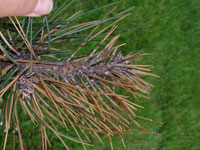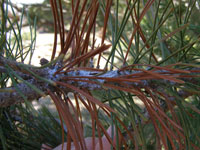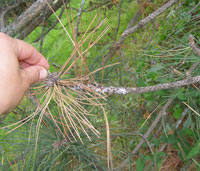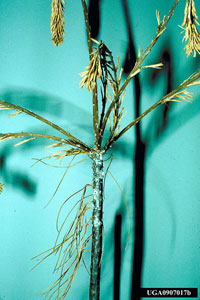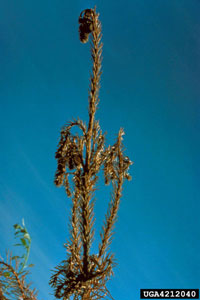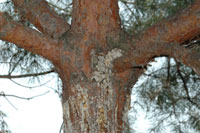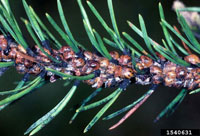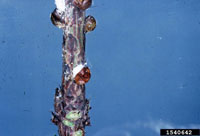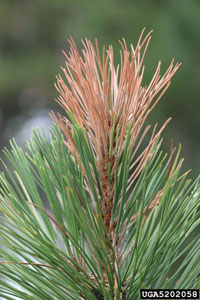Extension > Garden > Diagnose a problem > What's wrong with my plant? > Evergreen Trees and Shrubs > Pine > Resin or sticky substance on shoots
Pine > Shoots/Branch Tips > Resin or sticky substance on shoots
1 of 5
Diplodia shoot blight
Diplodia pinea
- New needles are brown, short and often glued together with resin
- Cankers are resin coated flattened areas on branches
- Needles and branch beyond canker turn brown and dies
- Tiny, black, pimple-like fungal structures on dead needles and pine cones
- Infected shoots and dead branches occur throughout the tree but most commonly in lower canopy
- Cankers and dead needles can appear rapidly after wounding from hail, drought or other stress
- Olive to dark brown streaking in sapwood below cankers
- Common on Austrian, red and Scots pine
- More information on Diplodia shoot blight
2 of 5
White pine weevil
Pissodes strobi
- Terminal leader dead or dying, curled into a shepherd's crook
- Branches in whorls near the top may also wilt and die
- Repeated attacks can leave trees looking bushy
- Drops of sap from feeding wounds on terminal shoots in early spring
- Prefers Eastern white pine but will also infest jack pine and Norway and blue spruce
- Small, ¼ inch long, white, grub-like larvae feed under bark from June to August
- Adult weevils ¼ inch long, dark with tan and white mottling; has conspicuous snout
- More information on White pine weevil
3 of 5
Zimmerman pine moth
Dioryctria zimmermani
- Dead terminal leader and shoots are common
- Larvae feed at branch whorls and a base of shoots
- Pitch mixed with reddish frass just below feeding sites
- Affected shoots turn brown and may break off
- Larvae are dark pinkish-green, about ¾ - 1 inch long
- More information on Zimmerman pine moth
4 of 5
Pine tortoise scale
Toumeyella parvicornis
- Moderate feeding can cause needles to yellow and become shortened
- Heavy infestations can cause shoots and branches to die back
- Feeding produces honeydew which can cause sooty mold
- Individual scales are reddish-brown, helmet-shaped and up to ¼ inch long when mature
- More information on scale insects
5 of 5
Red pine shoot moth
Dioryctria resinosella
- Small pitch mass at point of entry
- Infested shoots turn red to brown
- Tree become flat-topped after several years of feeding
- Favors red pine, particularly on dry, sandy sites
- Larvae have dark head with body that varies from blackish to reddish-purple on top and white to green underneath
- More information on Red pine shoot moth



